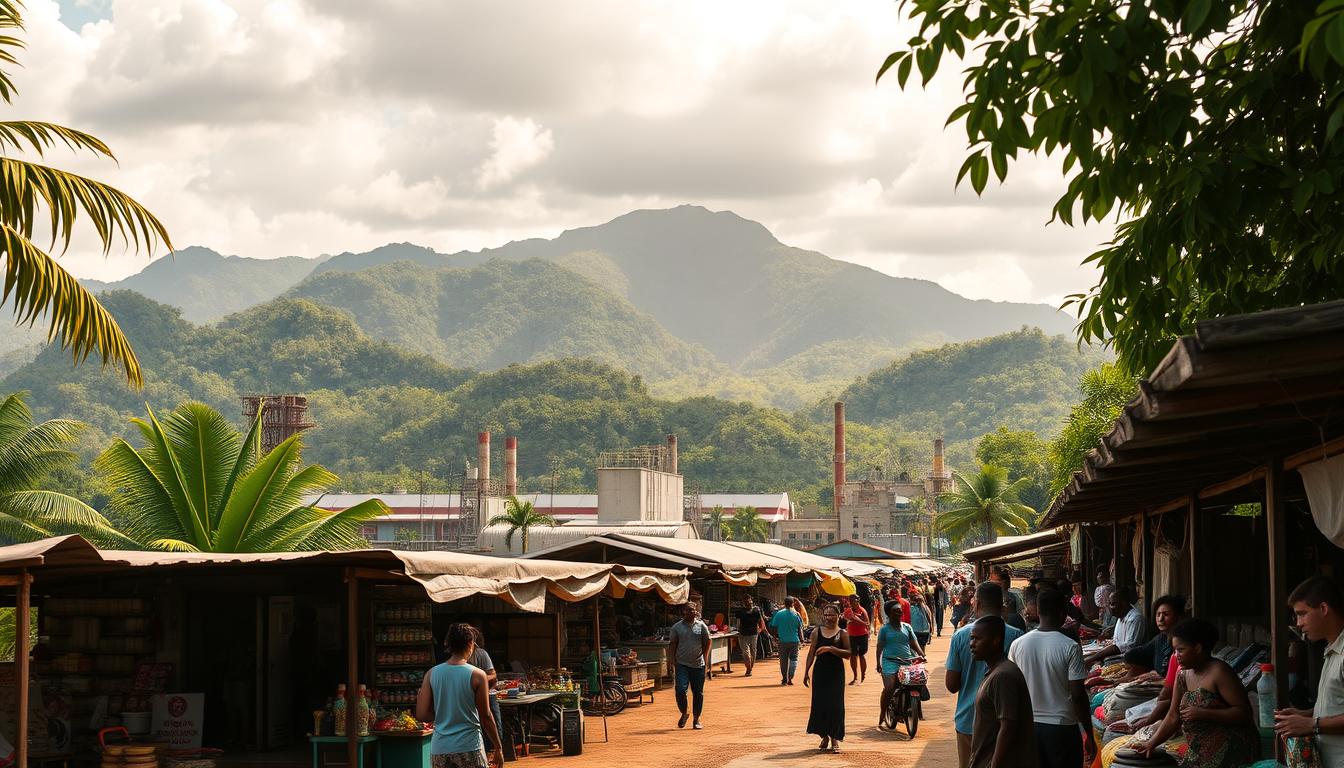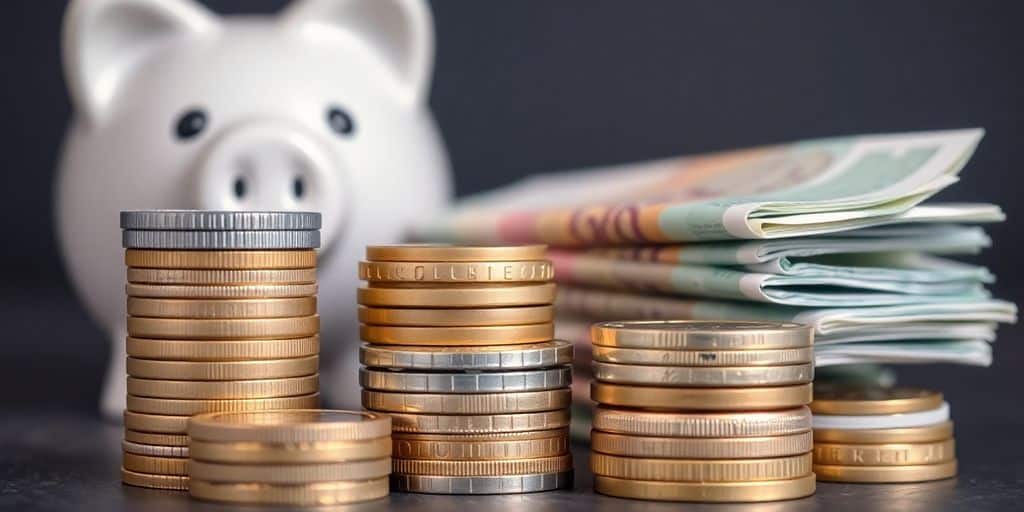Anúncios
Do you want a card for every moment?
Guyana, a small South American country, is rich in natural resources. These significantly impact its economy. The discovery of huge oil and gas reserves has majorly boosted its GDP. From US$6,477 in 2019, it soared to US$18,199 by 2022.
This remarkable growth makes Guyana one of the world’s fastest-growing economies. However, this dependency on oil poses challenges for the future. It brings up questions about economic variety and ongoing success.

Republic Bank OneCard
Yet, agriculture continues to be a backbone, supporting jobs and food stability. Looking ahead, Guyana needs to focus on reducing poverty. It’s important to make the most of its natural wealth for continued growth.

Overview of Guyana’s Economic Landscape
Guyana’s economy is thriving, thanks to its natural riches like oil, gas, farming, and mining. The discovery of offshore oil has greatly boosted its GDP. This has moved Guyana from a struggling economy to a fast-growing market. Farming and mining are big too, bringing in money and jobs.
Yet, Guyana faces hurdles. Most people live along the coast where poverty and climate threats are real. These challenges affect the entire economy. The focus is on sustainable growth in all sectors. As Guyana grows globally, it aims to use its natural riches well. It also looks to solve problems affecting its people.

Major Economic Drivers: Oil and Gas Sector
Guyana’s oil and gas sector is a big part of the country’s economy. It’s changing the way other sectors operate too. A big jump in oil production shows how fast the industry is changing. This growth is also boosting the country’s GDP, showing how oil production and financial health are connected. The future looks bright for oil in Guyana, making it a top economic driver.
Recent Developments in Oil Production
Oil production in Guyana has skyrocketed. It went from no production in 2019 to an estimated 613,000 barrels per day by 2024. This leap is thanks to new technology and investments in oil fields. Now, Guyana can use its oil reserves well.
Impact of Oil on GDP Growth
Oil is a huge part of Guyana’s GDP. It’s expected to help achieve high GDP growth rates in 2023 and 2024. In 2022, oil exports were about 88% of all exports. This shows how important oil is for the country’s economy.
Future Projections for Oil Sector Growth
The future of oil in Guyana looks promising. Big projects like Yellowtail will boost oil production even more. This sector is expected to keep growing. It puts oil production at the heart of Guyana’s economic progress.
Economic Diversification: Challenges and Opportunities
Guyana’s economy is deeply tied to its oil sector. This reliance brings challenges like market swings and price changes. With possible economic downturns, it’s clear the country needs a wider economic focus.
Expanding sectors like agriculture, mining, and services is key. These areas offer great development chances. They can also make the economy more stable. By focusing here, Guyana could lessen its oil dependency and ensure lasting growth.
- Enhancing the tourism sector to draw international visitors.
- Investing in technology to support new industries.
- Strengthening infrastructure, which can facilitate growth across various non-oil sectors.
These steps show how Guyana can diversify its economy. Doing so could bring stability and resilience for the future.
Guyana’s Agriculture: A Key Pillar of the Economy
Agriculture is a key part of Guyana’s economy, driving its non-oil exports. It doesn’t just provide goods but also supports many people’s lives. Knowing how important agriculture is helps us see its value from different views.
Key Agricultural Products and Exports
In Guyana, agriculture is diverse, with many products that are crucial for exports. The main ones are:
- Rice
- Sugar
- Shrimp
These exports boost income and financial stability for Guyana. They make Guyana important in international trade, especially in the Caribbean.
Impact of Agriculture on Employment
In Guyana, farming provides jobs, especially in countryside areas. Many families there depend on agriculture to live. A big part of the workforce does farming work, showing its role in employment. However, there are challenges like climate change and needing better farming tools. To keep jobs and improve work, it’s crucial to use sustainable practices and new technologies.
The Role of Natural Resources in Economic Development
Guyana’s vast natural resources are key to its growth. Minerals, forests, and eco-tourism are especially important. The country has a lot of minerals like bauxite and gold. These are crucial for making money from exports.
Investing in mining attracts foreign interest. This boosts the economy and creates jobs.
Mineral Resources and Their Economic Contribution
The mining sector is a big part of Guyana’s economy. It includes the extraction of important minerals. Bauxite and gold mining shape Guyana’s trade with other countries.
They bring in money which helps local communities. This money is used for improving infrastructure and public services.
Forestry and Eco-tourism Potential
Forestry is another way Guyana can develop economically. The country’s forests provide chances for sustainable timber production. Meanwhile, eco-tourism takes advantage of Guyana’s diverse wildlife and beautiful scenery.
As more people look for green travel options, Guyana can turn its unique nature into popular tourist spots. This promotes conservation and helps local communities economically.
Poverty Reduction Trends in Guyana
Guyana’s poverty rates have fallen significantly in recent years. The drop from 60.9% in 2006 to 48.4% in 2019 shows big efforts in fighting poverty. But finding out the latest poverty details is hard because of few recent stats.
Status of Poverty in Recent Years
Even with lower poverty rates, economic inequality is still a problem. People, especially in rural areas, struggle to get basic services. This highlights the need for ongoing efforts and new strategies to reduce poverty.
Government Initiatives for Poverty Alleviation
The government is tackling economic inequality with several plans. Programs are set to improve access to schools and healthcare. Also, investing in better infrastructure helps close the development gap between city and countryside, raising overall living standards.
Education Sector: Building Human Capital
The education sector in Guyana is key in forming the country’s human capital. Recent data shows big steps forward in school enrollment, especially for young kids. At nursery and primary levels, enrollment hit 91% and rose above 100% by 2022. This shows a strong effort to make education available to all.
Enrollment Rates and Educational Achievements
These high enrollment numbers signal a big change towards better education. Having access to a good education helps students learn more effectively. The government’s efforts to increase enrollment are working, but there’s still work to do to improve learning and achievement.
Challenges in Learning Outcomes
Even with higher enrollment, there are still hurdles to overcome in learning. Kids born right before the COVID-19 pandemic may fall behind their peers. It’s crucial to tackle these challenges to fully tap into Guyana’s human capital. By improving education quality, training teachers better, and reducing the gap between urban and rural areas, we can build a stronger future.
Health Outcomes and Economic Implications
The health of people in Guyana and the country’s economic growth are closely linked. For example, the infant mortality rate is 23.2 for every 1,000 babies born alive. This rate and the under-5 mortality rate of 28 per 1,000 both exceed the averages for Latin America and the Caribbean.
Current Health Statistics
The data highlights a critical need for better healthcare in Guyana. High infant and child death rates point to the importance of better healthcare for mothers and children. Improving access to essential health services can boost the well-being of people and the country’s economy.
Link Between Health and Economic Productivity
There’s a strong connection between health and how well an economy does. When people are healthier, they can work more efficiently, raising productivity. Spending on health services is key to lowering medical costs and supporting economic growth over time. Better public health can lead to healthier people and a stronger economy.
The Impact of Climate Change on Guyana’s Economy
Guyana faces big challenges because of climate change. Coastal flooding is putting areas at risk. This affects farms and important buildings, hurting the economy.
Risks Associated with Coastal Flooding
Coastal flooding is a major problem for Guyana. It leads to:
- Destruction of farmland, causing food shortages and lost income.
- Damage to roads and water systems.
- Higher health risks from bad water and sanitation.
These challenges show why it’s crucial to fight the effects of climate change.
Government Strategies for Climate Resilience
The government of Guyana has plans to fight these climate issues. Its strategy until 2030 focuses on:
- Keeping forests safe to stop floods and protect animals.
- Using clean energy to lower pollution.
- Helping communities deal with climate change effects.
This approach will help Guyana handle climate change better and grow in a sustainable way.
Guyana’s Economy: Trends and Insights into Future Growth
Guyana is at a turning point, seeing big economic improvements. This growth comes mainly from the oil industry. As the country adjusts to new economic patterns, it’s looking at a bright future.
Expected Economic Growth Rates
In 2024, Guyana’s economy might grow by 27%. This is because of its oil production and its positive impact on other areas. This growth shows Guyana could become a key global economic figure.
Key Sectors for Future Investment
For continued growth, Guyana is seeing new investment opportunities. These are crucial areas:
- Infrastructure: Enhancements to transportation and utilities are essential for supporting increased economic activities.
- Healthcare: Strengthening health services is vital for accommodating a growing population and improving overall quality of life.
- Education: Investing in educational institutions will help cultivate the skills required in a rapidly evolving workforce.
- Construction: The non-oil sector, particularly construction, promises diversification in a booming economic landscape.
- Information and Communications Technology (ICT): Advancements in this area can enhance connectivity and foster innovation across sectors.
By investing in these areas, Guyana can protect itself against oil price changes and keep growing economically.
Conclusion
The Guyana economy is going through big changes, mostly because of its growing oil and gas sector. This is a key time that shows us the opportunities for growth in the future. But, it’s important to remember that depending too much on oil carries risks. We need a smart plan for growth that includes different areas, not just oil.
The government must handle climate risks, social inequalities, and complex problems carefully. Making sure the economic growth helps everyone is key. If we don’t, the oil sector’s growth could make inequalities worse instead of better.
Guyana is on the edge of a bright economic future, with lots of chances for investment in different industries. While oil is making quick money now, industries like agriculture and tourism are essential for a strong economy. The road ahead has challenges, but there’s a lot of hope for making things better.


